#Saint LaVeau
Text
I CALL MY DIVINE ENERGY BACK TO ME.
🧿MAY ALL LURKING EVIL EYES BE BLINDED 🧿
I am fully protected from wickedness, seen and unseen.

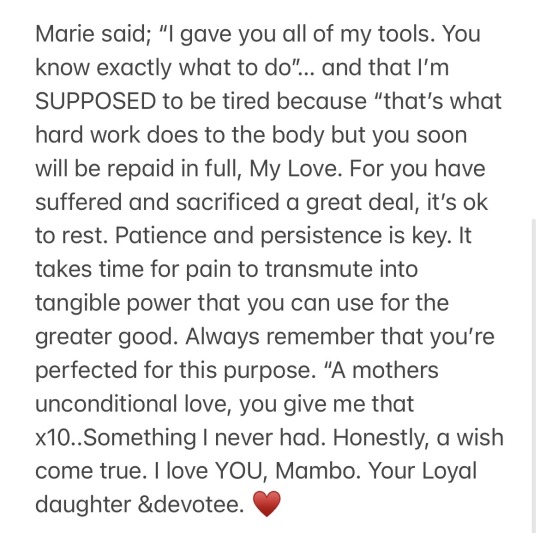
#I Love You Mambo#Mary Incarnate#Saint LaVeau#MY MOMMY FOR REAL#I love you mommy#PROUD#Ghost Girl#♥️#coronated#I DIDNT CHOOSE THIS PATH#IT CHOSE ME#I WILL REIGN SUPREME AS QUEEN OF THE VOODOOS#👑#annuit coeptis#novus ordo seclorum
5 notes
·
View notes
Text
On September 10th we venerate Elevated Ancestor, Voodoo Queen of Louisiana, & Saint, Marie Catherine Laveau on her 222nd birthday 🎉
[for our Hoodoos of the Vodou Pantheon]

Marie Catherine Laveau was a dedicated Hoodoo, healer, herbalist, & midwife who, "traveled the streets [of New Orleans] like she owned them", as the most infamous Voodoo Queen of New Orleans.
Marie C. Laveau I was born a "Free Mulatto" in today's French Quarter in what was then, New France); to a mother & grandmother who were both born into slavery & later freed via freedom papers. It is believed that she grew up in the St. Ann Street cottage of her maternal grandmother.
She married Jacques Santiago-Paris, a "Quadroon" "Free Man of Color", who fled as a refugee from Saint-Domingue, Haiti from the Haitian Revolution in the former French colony . After his passing, she became known as "The Widow Paris". She then worked as a hairdresser catering to White families & later entered a domestic partnership with a French nobleman his death. She excelled at obtaining inside information on her wealthy patrons by instilling fear in their servants whom she either paid or cured of mysterious ailments. Although she never abandoned her Catholic roots, she became increasingly interested in her mother’s African traditional beliefs. The Widow Paris learned her craft from a ‘Voodoo doctor’ known variously as Doctor John or John Bayou.
Marie C. Laveau I is said to have intiated into Voodoo career sometime in the 1820s. She's believed to be descended from a long line of Voodoo Priestesses, all bearing her same name. She was also a lifelong devout Catholic. It didn’t take long before Marie C. Laveau I dominated New Orleans Voodoo culture & society before claiming title of Queen. She was the 3rd Voodoo Queen of NOLA - after Queen Sanité Dédé & Queen Marie Salopé. During her decades tenure, she was the premier beacon of hope and service to customers seeking private consultations - to aid in matters such as family disputes, health, finances, etc, created/sold gris gris, perforemed exorcisms. While her daughter Marie II was known for her more theatrical displays of public events, Marie C. Laveau I was less flamboyant in her persona. She conducted her work in 3 primary locations throughout the city: her home on St. Ann Street, Congo Square, & at Lake Pontchartrain. Despite one account of a challenge to her authority in 1850, Marie C. Laveau I maintained her leadership & influence.
The Queen died peacefully in her sleep in her ole cottage home on St. Ann Street. Her funeral was conducted according to the rite of the Catholic Church & in the absence of any Voodoo rites. To her Voodoo followers, she's venerated as a Folk Saint. In² addition to her Priesthood in Voodoo and title of Queen, she is also remembered for her community activism; visiting prisoners, providing lessons to women of the community, & doing ritual work for those in need.
She is generally believed to have been buried in plot 347, the Glapion family crypt in Saint Louis Cemetery No. 1, New Orleans. As of March 1st, 2015, there is no longer public access to St. Louis Cemetery No. 1. Entry with a tour guide is required due to continued vandalism & tomb raiding.
We pour libations & give her💐 today as we celebrate her for her love for & service to the people, through poverty, misfortune, bondage, & beyond.
Offering suggestions: flowers + libations at her grave, catholic hymns, holy water, gold rings/bracelets, money
‼️Note: offering suggestions are just that & strictly for veneration purposes only. Never attempt to conjure up any spirit or entity without proper divination/Mediumship counsel.‼️
#hoodoo#hoodoos#atr#atrs#the hoodoo calendar#conjure#rootwork#rootworkers#ancestor veneration#Marie c Laveau#Voodoo#Voodoo Queens#new orleans#new orleans Voodoo#Vodou Pantheon#Haitian Voodou
361 notes
·
View notes
Text
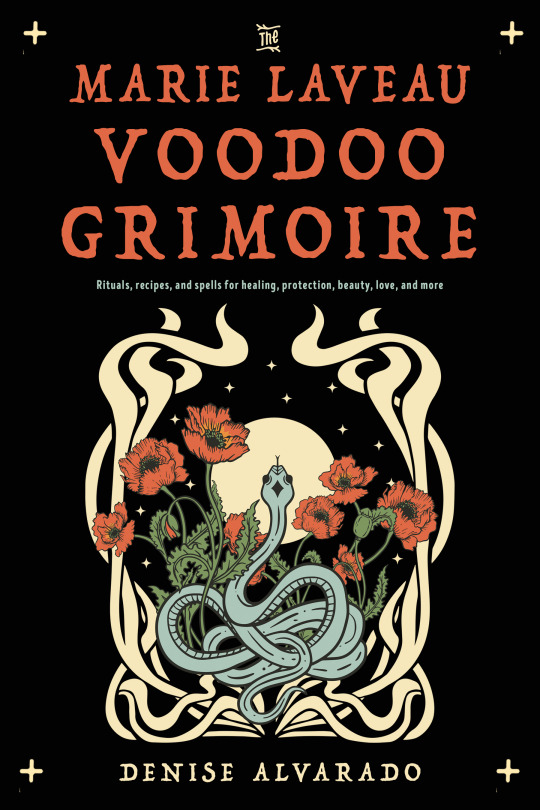
Marie Laveau was one of the wisest women that ever lived.
She was gifted with a power from on high that very few people are gifted with. She could look at you without ever having seen you before and tell you where you were born, what hour you were born and the time, and also the condition of the weather if you wanted to know that. She was, in a way, to me another Solomon, sent from the Almighty God above to come down here and help his people. I also picture her as a John De Baptist who comes to teach right and righteousness. This woman that I am telling you about prayed not three times a day as Daniel did but prayed every hour in the day that our Heavenly Father sent. I picture her as one chosen by God’s own hand. She was not selfish, but waited on the Black as well as the White, and the rich as well as the poor. Doing all the good stuff she could. And never doing any harm to anybody.
~Old Man George Nelson, 1936
Marie Laveau possesses an enduring magick as the preeminent witch queen, Voodoo Queen, and heavenly Saint in New Orleans. Her style of Voodoo encapsulates all the mystery, glamour, and power every witch, folk magic practitioner, and Vodouisant longs for. And let’s face it, witches love pretty things - shiny black mirrors and crystals and stones, beautiful tarot cards, and gold embossed velvet bags in which to keep them. We love the smell of incense, flowers, and perfumes as much as the aroma of a healing chicken soup on the kitchen stove. Living a tradition that is, in its very essence, natural, harmonious, and exquisitely beautiful, we see the allure in what others may deem profane. In The Marie Laveau Voodoo Grimoire, I continue where The Magic of Marie Laveau left off. This book is a working grimoire geared towards the modern witch and conjure worker that provides spells, advice, formulas, and recipes for solving the problems of daily living and enhancing quality of life in the most magickal of ways.
Available direct from the author here: The Marie Laveau Voodoo Grimoire (creolemoon.com)
If you would like a signed copy, just make a request upon checkout and I will be happy to sign a copy for you.
#hoodoo#conjure#rootwork#creolemoon#neworleansvoodoo#witchcraft#marielaveau#authordenisealvarado#new orleans voodoo
30 notes
·
View notes
Text

If you spend any time reading or listening to things about New Orleans, you will undoubtedly come across the name of Marie Laveau. Born a free woman of color on this day, Sept. 10, in 1801, most references invariably refer to Laveau as New Orleans’ “Voodoo Queen.” And indeed, she was a leading practitioner in New Orleans throughout much of the 19th century, but this is only a part of her story. Laveau was also a prominent and successful entrepreneur, the owner of the beauty parlor where she worked as a hairdresser. She worked to provide educations for women in New Orleans' Black community. She was well known for visiting and ministering to prisoners, especially those on death row. And during the Yellow Fever epidemic of 1853, she used her knowledge of plant medicine to nurse the sick – she’s credited with saving many lives in the process, arguably more than were saved by the conventional medical practices of the day.
Marie Laveau had become one of New Orleans more prominent citizens when she died in 1881. She’s buried in Saint Louis Cemetery Number 1, where her tomb is visited by thousands every year.
50 notes
·
View notes
Text
Marie Laveau. Voodoo Queen.

Marie Catherine Laveau (September 10, 1801 – June 15, 1881) was a Louisiana Creole practitioner of Voodoo, herbalist and midwife who was renowned in New Orleans. Her daughter, Marie Laveau II (1827 – c. 1862), also practiced rootwork, conjure, Native American and African spiritualism as well as Louisiana Voodoo. Her daughter was to me the most powerful one.
Her Real Story. Her house was probably on St. Ann St. She would have lived in a creole cottage similar to the one in this picture but probably not as clean.

She did have kids with her husband but there's no record of them as adults so they probably died young. Her and her husband did get married at St Louis cathedral he was a Haitian man.Then sometime around 1825 Jacques Perry her husband so called disappeared they tried to make it a big mystery but in all honesty people back then didn't really report that loved ones death. After St Louis cathedral burned down they lost all the records so later on she started calling herself the widow Perry. The story of her actually being a hairdresser there is no record her being a hairdresser there was a book that was written by George Washington Cabal in 1880 who wrote about a voodoo priestess who was a hairdresser and people later on assume that he was speaking about Marie Laveau. There was also another man Kristoff Glapion and one of the stores that they have of him is that he was born a free man of color but record show that he was actually born of two white parents. She wasn't married to this man kristoff because at that time a black woman could not marry a white man but she did stay with him and she stayed with him until his death. They stay together for probably around 30 years and then she includes him in the Perry tomb. After kristoff died she was in so much financial debt they had to sell off the house on Saint Ann Street to pay for his funeral and anything else that needs to be paid off. So she didn't have a place to stay until one of their family friends name Crocker bought the property and let her stay there until she died.
Legend.
The legend of Marie Laveau it runs deep through the veins of New Orleans. The Voodoo priestess was believed to have been born free in the French Quarter of New Orleans, Louisiana, about 1794, the daughter of a white planter and a free Creole woman of color.
The source of this power was the Voodoo religion and its queen, Marie Laveau. She was worshiped at the same time she's was feared by people of all races. Some people believe that her powers were actually based on a network of informants. Being a hairdresser, she was able to lesson to her clients (mostly white) gossip. She used this inside information to influence and instill fear in her believers. Whether or not the legends of this Voodoo priestess are true, it cannot be denied that she has left her mark on the city. She was buried in Saint Louis Cemetery No. 1 in New Orleans in 1881. Her daughter in St Louis cemetery no. 2

To this day her and her daughters tomb continues to attract visitors who unlawfully desecrate it by marking three “x”s (XXX) on its side, in the hopes that Laveau’s spirit will grant them a wish. Ok, let me say first no one who practices Voodoo whenever desecrate a grave of writing on it second she isn't a voodoo spirit since Louisiana Voodoo is part Haitian and African she's not a elevated spirit. She's a woman that is well known and well respected within our city. What she really is in voodoo. She's a conjured spirit similar to a saint she is called upon to do a specific task.

Here is a pic I took of the largest international Marie laveau shrine in the US.
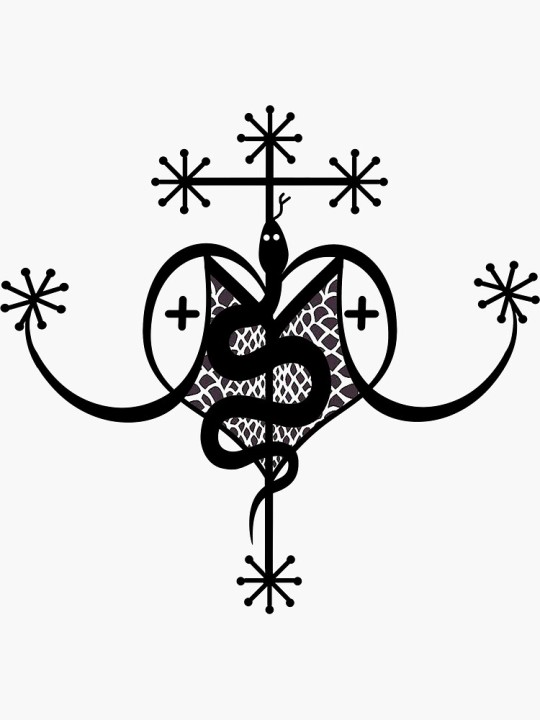
BECOMING A DEVOTEE: these days Marie Laveau devotees are no different they still believe in Jesus and saints, just as Madame Marie did. They go to church, pray the rosary, and work the gris gris. Some voodooist here in New Orleans believe Marie Laveau is one of the Lwa (Loa) in Voodoo tradition. She is honored on many altars and shrines through New Orleans. People pray to her or even make wishes to her. Understand who she was and what she did for people and the city. The rituals and blessings she preformed like the St John's Eve blessings. So get to know her.
BUILDING AN ALTAR Building her altar isn't complicated a statue or pic of her. You can add flowers. Candles white, blue or red or even add her veves. (symbol) (normally she wouldn't have the symbol because she's not a voodoo spirit but she's important so they made one for her anyway)
OFFERING: This can be flowers, mini liquor bottle, cigarettes, cigars. Money she's not picky.
Your relationship with spirit will be different from the next person’s. The connection you make with Marie Laveau will be unique to only you.
This video I took of her shrine in The Healing Center. In New Orleans.
If your in the city check it out on St Claude in the building is the Island of Salvation Botanica own by priestess Sally Ann.
#Marie Laveau#Voodoo Queen#New Orleans Voodoo#Spiritual#Altar#Shrine#like and/or reblog!#google search#southern voodoo#follow my blog#ask me anything#Voodoo story.#african spirituality#african diasporic#Voodoo priestess#louisiana voodoo#update post
22 notes
·
View notes
Photo

INSTAGRAM: catlandbooks
Throughout Africa and beyond in the diaspora caused by the slave trade, the divine feminine was revered in the forms of goddesses like the ancient Nana Buluku, water spirits like Yemaya, Oshun, and Mami Wata, and the warrior Oya. The power of these goddesses and spirit beings has taken root in the West. New Orleans, for example, is the home of Marie Laveau, who used her magical powers to become the “Voodoo Queen” of New Orleans.
Author Lilith Dorsey shows us in Orishas, Goddesses, and Voodoo Queens how to celebrate and cultivate the traits of these goddesses, drawing upon their strengths to empower your own life. In addition to offering a guided tour of the key goddesses of the African religious traditions, the book offers magical spells, rituals, potions, astrological correspondences, sacred offerings, and much more to help guide you on your own transformational journey.
——
New Orleans has long been America’s most magical city, inhabited by a fascinating visible and invisible world, full of mysteries, known for its decadence and haunted by its spirits. If Salem, Massachusetts, is famous for its persecution of witches, New Orleans is celebrated for its embrace of the magical, mystical, and paranormal. New Orleans is acclaimed for its witches, ghosts, and vampires. Because of its unique history, New Orleans is the historical stronghold of traditional African religions and spirituality in the US. No other city worldwide is as associated with Vodou as New Orleans.
There is a mysterious spiritual underbelly hiding in plain sight in New Orleans, and in this book Alvarado shows us where it is and who the characters are. She tells where they come from and how they persist and manifest today. Witch Queens, Voodoo Spirits, and Hoodoo Saints shines a light on notable spirits and folk saints such as Papa Legba, Annie Christmas, Black Hawk, African-American culture hero Jean St. Malo, St. Expedite, plague saint Roch, and, of course, the mother and father of New Orleans Voudou, Marie Laveau and Doctor John Montenée.
#new orleans#witch#witchery#witchcraft 101#Marie Laveau#Annie Christmas#vodou#salem#salem massachusetts#vampires#spirits#espiritualidad#espiritismo#ritual#Yemaya#Oshun#Orishas#Oya#goddess#goddesses#saints
92 notes
·
View notes
Note
Can the spirit of a world figure like Cleopatra be summoned in necromancy even if she had been dead for more than 1000 years, or the deceased has already been put to rest for so much time that she had already reincarnated thus there is no one "to call" in the first place
So this assumes a belief in reincarnation which not all occultists hold and even if they do, not all occultists agree on how it occurs. I personally believe only a portion of what we call a soul is reincarnated, the lower portion specifically. I believe the memories of past incarnations are patterned into the higher portion and help inform and direct what we know as True Will. A tapestry of incarnations. But these also exist in a pool of consciousness within the Godhead. All things that have ever been exist in one sense or another within the body of Nuit unmanifest. This means that one portion of your being reincarnates into matter whilst another can still be tapped into and ‘summoned’ by a magician. This is just my opinion, or one of them.
Then we come to people like Cleopatra. She isn’t a normal spirit, a pharaoh was considered a God. When people have a mythos attached to them, stories, are a part of the world consciousness they become what some call ‘mighty dead’. I believe that these beings are elevated to this status and become sort of Demi-gods, or at least more than a human spirit. They are sort of part spirit and part egregore and it is where some people believe Gods originated. I do not, but that’s another discussion. I believe the mighty dead are something else entirely, I believe they are a created spirit in their own right. The essence of their deeds live on and gain power the more people work with them. It is the same with figures such as Marie Laveau who is still worked with by practitioners in New Orleans, she has become a legend. She has gained power in death for being someone you want on your side if you are working magic. She is like a Saint to practitioners in New Orleans and like saints has become part of the mighty dead.
I don’t believe all of our spirit exists within our physical body or even our mind. I believe it is much larger than that. I believe that only a portion, a fragment is reincarnated. Which leaves the other portion free to exist anywhere and everywhere at the same time. We are all God head, yet when we incarnate we retain a sense of individuality, this is an illusion, but it also prevents us from seeing the entire spectrum of our Selves.
I am really struggling to make logical sense here, its a hard thing to explain. I simply can’t write it. I would say you can only truly grasp what I mean when you have experienced HGA experiences and etheric projection. As for the tapestry of will and how I believe it works there was a really good episode of Lovecraft country called “I am” in which one of the characters experiences the experience of different people. Whether she was those people in a past life, or is entering the memories of those people, or something else is irrelevant, those experiences inform here about her own purpose. That is how I feel about reincarnation and past life memories. She is all of them because she is also God and God is all of creation. I am you reading this right now, just as you are me typing it. All memories, all past life experiences are in a sense all of our experiences because we are in a sense only One. And that one exists outside of time and space which means you can call upon and work with different aspects at any time. Time and Space are further illusions, I believe we all achieve enlightenment at the same point, but it is outside of linear time. We are all fragments of one being exploring the vast intricacies of creation.
And we will stop the ramble there.
19 notes
·
View notes
Text
Our readings this week:
The Revolution Denied, Davis, R. (1999). American voudou : Journey into a hidden world
Crimes of Ritual Assembly and Assemblage in Colonial and Revolutionary Saint-Domingue, Ramsey, Kate (2011), The Spirits and the Law: Voudou and Power in Haiti
In addition to the readings from Davis and Ramsey, as well as De Las Casas, I ended up reading the book Jambalaya by Luisah Teish. A huge theme in all of these readings was the suppression of religion and magical practices. Miss Teish in her book described how in the 1820s, a rash of anti-Voodoo sentiment and legal action resulted in the interdiction of all dancing in Congo Square in New Orleans.
What was significant about this is that the public dances were already a decoy for the actual Hoodoo (different from Voodoo) ceremonies. Anyone was allowed to join the public dances, featuring the Cabinda and Carabine, but the Black Codes of Louisiana resulted in restricting the public gatherings of Blacks, just as they had been restricted and ruthlessly controlled in the Caribbean more than a century earlier, and as had been repeated time and again (as discussed in The Revolution Denied). In an act to stop the bans and restrictions, the masters, police, and oppressive dominating white overseers ended up receiving direct invitations from the famous Marie Laveau, who hosted these dances during this time even into the 1850s, to allow her and others the opportunity to continue their religious work. The participants who were not free would return to their quarters after the dance, while “Mam’zelle Laveau,” a free woman, would invite wealthy clients and prominent public figures into her home, where she secured friendship with them, and invited many to participate in her own Hoodoo practices (which they often did, including purchasing Gris-Gris and other charms and rituals from Miss Laveau).
As the bans and control of public gatherings and dances continued, many would flee from larger cities to smaller towns, where they could continue their practices in private or create secret courts. However, there were those who refused to flee and fought to stay firm in their rights that was meant to be granted through the First Amendment. “On this occasion the police had arrested a large group of women— white, black, and of mixed color— while they were gathered for a Voodoo dance and proceedings which those making the arrests described as indecent and orgiastic in character. These women…refused to admit the charges made against them. …They summoned eminent counsel, who argued…that such Voodoo practices were purely religious and that the law had no justification for its attitude toward them. In order to justify the arrests, the courts… seem to have been compelled to fall back upon and ordinance forbidding the assembling of white women and slaves.” (Tallant, Voodoo in New Orleans, p. 35; Jambalaya, p. 202)
With these bans in mind, I wanted to reflect on how we have the Voudou practices we have today. Marie Laveau was instrumental in saving and keeping Voudou practices alive, as she helped originate the blending of worship of Catholic Saints and Voudou Gods, especially in States. St. John was the equivalent of the son of the Great Goddess, Chango, and St. Peter was the equivalent of Papa Legba. This isn’t unique to just Voudou or Miss Laveau but was something that happened throughout much of human history, often because of forms of colonialism or proselytism (involuntary and forced conversion; ex. Brigit, the Celtic Goddess of Flame, being turned into St. Brigid, or Our Lady of Guadalupe originating as a Mother Goddess before the first pope was born) but also just in cultural exchanges (Greeks adopting Egyptian deities). Blending deities is common in Brazil, Haiti, and Cuba (due to their histories with colonialism) but we also see Hindu gods worshipped beside traditional gods for many in West Africa.
All of this is to say, Marie Laveau was aware of the ability to blend these gods and practices, and she was adept at socially and culturally engineering the cooperation of the Catholic Church and Voundounsis, so much so that by 1863, known Voudou practitioners received Catholic sacraments.
In addition to blending worship, Marie Laveau also standardized Voudou rituals, holidays, and materials. Friday nights became Altar Nights, St. John’s Eve became the annual ritual, etc. She also was able to elevate the services of Voudou to the status of a business. Anyone could buy love charms or even a ritual to win a court case.
Voudou did eventually lose its unity, however this gave way to more independent and original developments of the practice. Voudou and magic is still practiced in her tradition today, with more individual flairs. While there may be less unity, what was significant was the rekindling of native/motherland practices, especially in slave communities. Song and dance in worship continued, rituals and initiations were kept alive. We still see this influence in Black communities and styles of worship.
What struck me the most in all of these readings is the attack on personal, private practices. Oppression and control begin with targeting religion, sex, and other affects of an individual’s private life. Their relationships are banned, their rituals are banned, even seeing each other is banned. It is so insidious and so infuriating that those acts, how I choose to pray or worship which only affect me, are used to steal away identity, to isolate peoples and weaken them.
With this in mind, I am very interested to learn of and speak to Miguel Sague, our special guest speaker who will share with us his Taino heritage, and wish to know of his personal practices and how he keeps them alive. I want to know what he feels is most important to his identity and his practices, especially in terms of what makes him feel connected to not just the past (as brutal as it is), but to the future (which we can only hope will be better). How can communities help to keep those practices safe and alive? How can I as an individual help? Is it offensive to incorporate those practices into my own? Or is it keeping those practices alive?
Just some final thoughts, none of which are necessarily significant to what we are discussing as a class and what I’ve discussed individually. I know this was quite long, so thank you if you got this far. I had a lot that I had been mulling over the past week, especially as I read Jambalaya in conjunction with the selected readings and histories on the oppression of assembly and rituals. What was significant to me was after I finished the book, a few days later, I received a notification celebrating Marie Laveau’s birthday and I had missed it by 4 days. However, when I looked back, I realized I had began reading Jambalaya on Marie Laveau’s birthday. This was not known to me at the time nor was it intentional.
How auspicious, and how magical this class has been for me so far.
#colonialism#bruxas#witches#bruxa#feminism#postcolonialism#voudou#marie laveau#voodoo#jambalaya#religion#magic#Taino
4 notes
·
View notes
Text

the devereauxes have been in new orleans for so long and have so much pull that they know all the ins and outs of the city, and have access to areas that most of the public aren’t allowed without a licensed tour guide. of all these places, st. louis cemetery no. one happens to be the most important. not only do the devereauxes have a special pass to visit the cemetery, they’ve had a key to it for years, passed along from generation to generation, and updated whenever needed.
it’s here that their ancestor, marie laveau, was laid to rest. over a century ago, the devereauxes used to use marie’s tomb as a vault of sorts to hide all of their most prized possessions, such as spell tomes, rare herbs, and cauls, using marie’s notoriety as a means to keep people away from her tomb. this changed in 1982 when the misfits tried to exhume her corpse. a paranoid bunch, the devereauxes setup a secure, fireproof vault in their home, and transferred everything from marie’s tomb to there.
the devereauxes still visit her burial place, though, and leave offerings at her tomb and take dirt from her grave to use in rootworking practices (with permission, of course. you always gotta ask your ancestors first). her spirit is also closest here, so visiting makes it easier to consult her on sensitive matters. like all tombs, they make sure marie’s gets washed often, especially on holy days such as all saints day.

3 notes
·
View notes
Text
Marie Laveau
Nova Orleans não é tão distante para uma soteropolitana que viveu transitando entre cidade alta e cidade baixa. A capital de Louisiana (EUA) e a capital baiana se parecem muito: lugares de intenso movimento, mistura de povos, mistura de crenças, muita Magia.
Foi a Sereia Mística quem me apresentou a Marie Laveau, e quando ela me contou a história da Rainha Bruxa Vodu eu percebi que já conhecia a sua figura não só por tê-la visto em muitas ficções mas também porque Salvador é uma cidade cheia de grandes sacerdotisas.
Marie Laveau nasceu em 10 de Setembro, mas não sabemos se foi em 1794 ou 1801. Menina mestiça, filha de Margueritte, mulher negra haitiana, e Charles Laveau, homem branco e prefeito da cidade, Marie cresceu aprendendo com a mãe e a avó os ofícios do Vodu.
O Vodu tem raízes no Benim e no Congo e foi trazido para as Américas pelas pessoas escravizadas durante o século XVIII, especialmente para o região do Haiti, que era então uma colônia francesa e onde as práticas de vodu se fortaleceram ao ponto de influenciar a Revolução Haitiana entre 1791 e 1801 que culminou no fim da escravidão e independência do país. Esse evento permitiu a chegada do Vodu em Nova Orleans através das mulheres e homens negros emancipados que aportavam na cidade e lá a religião absorveu alguns elementos do catolicismo. A palavra Vodu tem várias grafias mas a tradução é a mesma: "espírito ancestral"; o culto às antepassadas, o sacerdócio das mulheres são a base de tudo.
Marie Laveau fez-se Rainha no Movimento.
“Marie Laveau era a grã sacerdotisa das cerimônias vodus de sua comunidade, ajudava a todas as pessoas, conduzia uma rede de suporte para as mulheres pobres, escravizadas, famintas ou que caíam na desgraça da sociedade de sua época. Cuidava dos cabelos das mulheres, assim como era reconhecida como curandeira, fitoterapeuta, leitora de cartas e feiticeira por toda a Nova Orleans.”
Amanda Maia, Ás de Tridente
Os relatos e as representações de sua imagem me levam de volta a minha cidade natal. Tantas Maries Laveaus eu vi, mulheres mestiças, olhar profundo e intenso, turbantes coloridos envolvendo os cabelos, perfumadas e usando roupas vistosas, caminhando pelo chão de paralelepípedos do Pelourinho ou circulando pela Praça Congo em Nova Orleans, mulheres que conhecem tanto e tudo, que cuidam e curam e que tem suas Casas sempre aberta para receber quem precisa de ajuda. Mulheres conselheiras, grandes mães para suas comunidades.
Existe muita imprecisão nos registros da vida de Marie Laveau, mas sua influência na cidade e na imaginação das pessoas ao longo do tempo é incontestável. Foi casada, mas o marido morreu jovem e com a herança deixada ela abriu um salão de beleza onde realizava atendimentos tanto estéticos quanto religiosos. Tinha uma cobra chamada Zumbi. Diz-se que morreu em 15 de junho de 1881, mas continuou frequentando as cerimônias vodu na Praça Congo: era sua filha, Marie Laveau II, que continuava os trabalhos da mãe. Ela foi uma das poucas que vingaram dentre os quinze filhos da Rainha Vodu. Na ocasião da sua morte um jornal local relatou: "morre em Nova Orleans uma mulher com história fantástica de quase um século". Dizem que ela se transformou num corvo e continua a observar a cidade da qual cuidou por toda a sua vida.
Embora esteja morta há mais de 100 anos, Marie Laveau continua no Movimento. Prova disso é o seu túmulo, no Cemitério de Saint Louis, sempre cercado de flores frescas, velas, oferendas e nas paredes pedidos de realização de desejos marcados com três X.
1 note
·
View note
Text

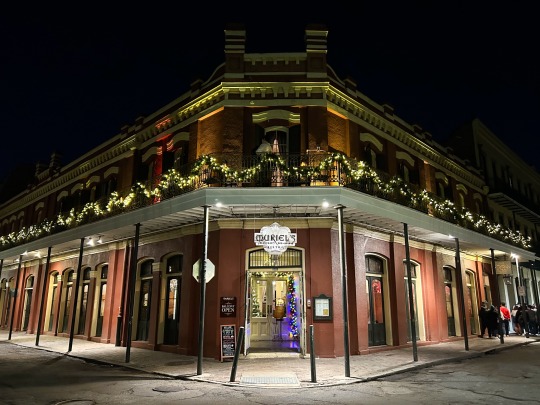
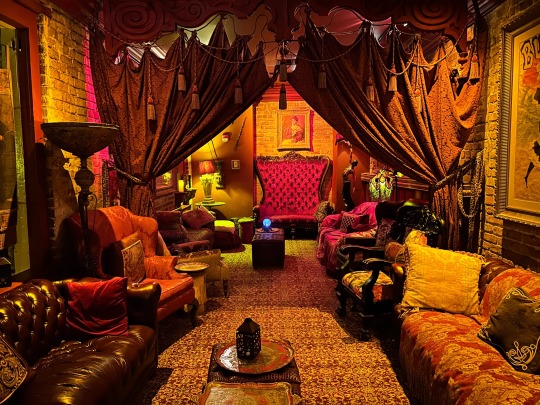



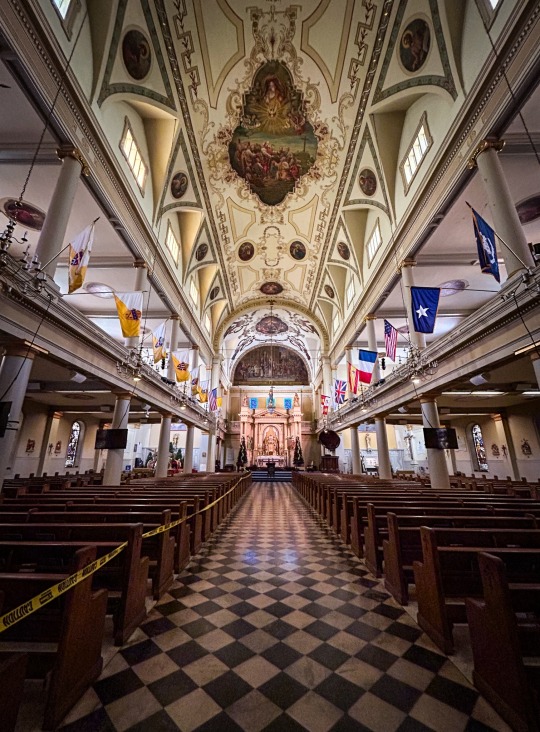



Vendredi 22 décembre
Je profite du long voyage de 8 heures en voiture vers St Augustine pour présenter des images inédites des trois derniers jours à la Nouvelle-Orléans, avec quelques faits intéressants et anecdotes.
A) Canal Street est l’unes des artères majeures de la ville (photo 1): très large, elle est emménagée avec un terre-plein central dédié aux tramways, et bordée de grands palmiers. D’un côté de la rue, c’est le quartier français historique, cumulant à la fois le passé français et espagnol de la ville, tandis que de l’autre, c’est le quartier financier associé à la culture anglo-saxonne. La rue est donc le point de rencontre des différentes cultures à la source du visage actuel de la Nouvelle-Orléans.
B) Mercredi, nous avons soupé chez Muriel’s, dont le bâtiment a été construit à la fin des années 1790, suite au grand incendie de 1788 ayant détruit une grande partie de la ville (photo 2). Son propriétaire était Pierre Antoine Lepardi Jourdan, un parieur qui finira par perdre la maison au jeu en 1814. Inconsolable, il se suicide dans une petite pièce du premier étage, où l’ont dit que son fantôme se manifeste sous la forme d’une lueur scintillante. Le restaurant a amménagé la pièce en question en un petit salon rouge qui semble être toujours prêt pour une séance de spiritisme (photo 3). Nous n’avons malheureusement pas aperçu le fantôme lors de notre passage…
C) Lors de notre visite au Cimetière Saint-Louis no 1, nous avons pu voir le monument funéraire familial qui contient les restes de la reine du vaudou, Marie Laveau (1801-1881). Icône de la Nouvelle-Orléans, elle suscite toujours l’intérêt et nombreux sont ceux et celles qui souhaitent obtenir ses faveurs encore aujourd’hui. La légende raconte qu’il faut tracer trois X sur sa tombe, tourner trois fois sur soi-même, et frapper sur la tombe. Ensuite, une offrande doit être faite pour que son souhait soit exaucé. On dit que les X encerclés signifient que le souhait s’est réalisé. Sur la photo, on peut voir quelques X inscrits, malgré le fait que le cimetière ne soit plus librement accessible au public, mais seulement lors de visites guidées et surveillées, et payantes (photo 4 et 5).
D) Le système de tramway de la Nouvelle-Orléans est le plus ancien au monde toujours en opération. Les plus vieilles voitures toujours en circulation ne datent pas du réseau original des années 1830, mais célèbrent tout de même un siècle de service: elles ont été fabriquées en 1923-1924 (photo 6).
E) Une image de l’intérieur de la Cathédrale Saint-Louis (photo 7), qui serait la plus ancienne sur le territoire des États-Unis, avec la Royal Presidio Chapel de Monterey, en Californie.
F) Congo Square est un petit parc situé juste au nord du quartier français (photo 8). Les autochtones fréquentaient le lieu avant l'arrivée des Français pour célébrer la récolte annuelle de maïs. Ce fut ensuite un lieu de rassemblement pour les esclaves d’origine africaine dès les années 1740, qui ont commencé à y tenir un marché public le dimanche, jour libre. Au 19ème siècle, ils y jouaient également des percussions, y dansaient et y chantaient, attirant des centaines de personnes. Ces rassemblements sont vus comme étant l’une des racines des célébrations du Mardi Gras dans le ville, mais encore davantage comme l’une des sources de ce qui deviendra le jazz de la Nouvelle-Orléans.
G) La maison Jean-Lafitte (photo 9) aurait été construite vers 1770, et serait donc l’une des plus anciennes de la ville (la plus ancienne était en travaux et éventrée lors de notre visite, pas de photo). Jean Lafitte (vers 1780-vers 1823) était un flibustier d’origine française, ayant joué un rôle significatif dans l’histoire de la Nouvelle-Orléans, notamment en participant activement à la bataille de 1815 contre les Britanniques, aux côtés du futur président Andrew Jackson, et en participant à l’intrigue liée au projet de libération de Napoléon de Sainte-Hélène. Il se serait peut-être servi de la maison à des fins de contrebande. Aujourd’hui, c’est un bar.
H) Enfin, pour boucler le tout en beauté, un clin d’œil à la première photo de la ville publiée lundi dernier: la maison LaBranche, dans ses habits de nuit cette fois !
0 notes
Text
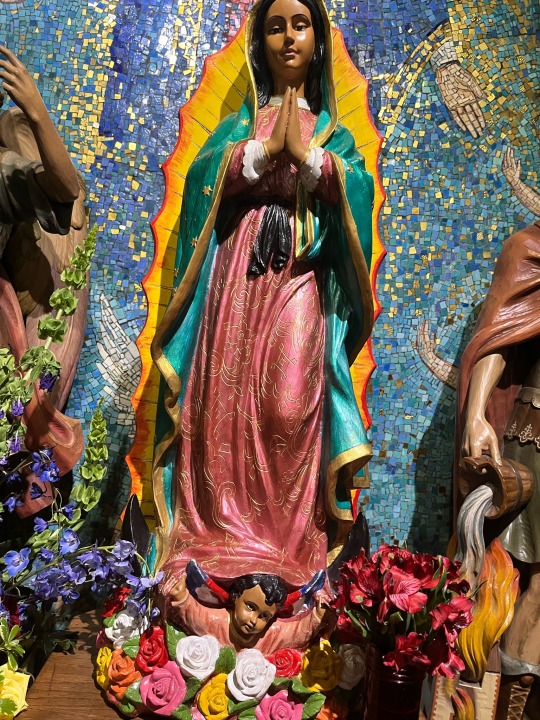




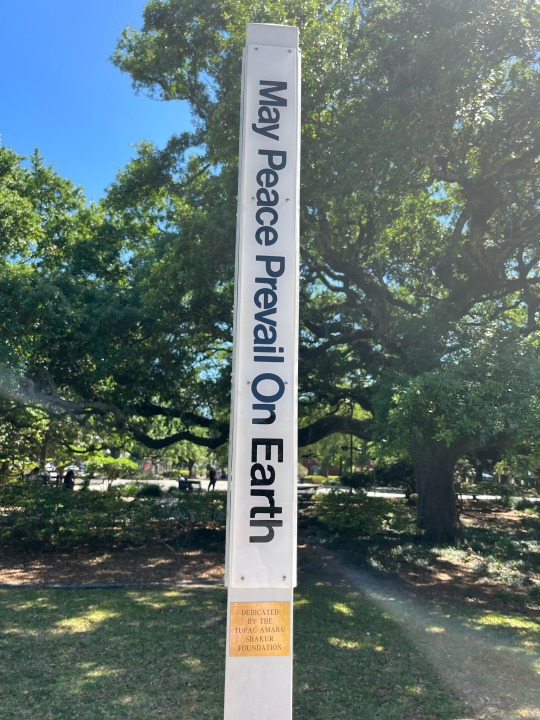
#crying is a understatement#i was bawling my eyes out#I LOVE YOU#SAINTS#SO THANKFUL#♥️#I LOVE YOU OUR LADY#I love you Amaru#Saint Amaru#Saint LaVeau#Saint Mary#Saint Baby in the making#✨#MAY PEACE PREVAIL ON EARTH#annuit coeptis#novus ordo seclorum
2 notes
·
View notes
Text
Witch Queens, Voodoo Spirits, and Hoodoo Saints: A Guide to Magical New Orleans by Denise Alvarado
My current audiobook is Witch Queens, Voodoo Spirits, and Hoodoo Saints: A Guide to Magical New Orleans by Denise Alvarado, read by Karen Chilton amd I've almost finished it. Not because it's a short book, but because it's a fascinating read and Chilton is an excellent performer.
I want to learn more about magic practices in the U.S. without accessing information that isn't meant for me. So, while the book is titled as a "guide," it is also an introductory history lesson of the above listed practices.
Alvarado divides her book by the New Orleans spirits who she writes about, the most well known in the book are (of course) Marie Laveau and Papa Legba.

I really love the section for Annie Christmas and how her folk stories are told in rhyme and about Mary Oneida Toups, the Witch Queen of New Orleans. I might get a hardcopy edition because Alvarado included indexes and figures, and there isn't a pdf download. There's some memoir writing, too, that I wish there was more of.
It's a great read, generally, and an enlightening one.
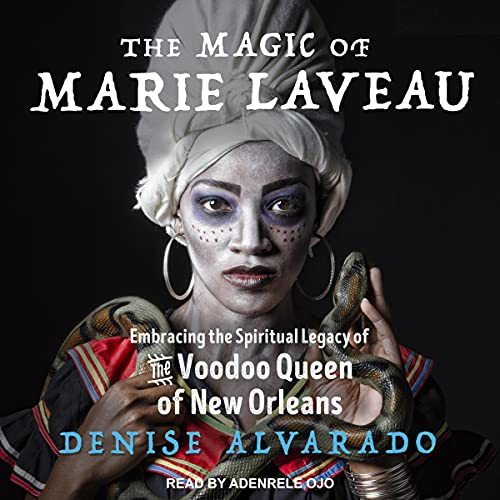
Alvarado has also published a book specifically about Marie Laveau, just fyi
0 notes
Photo
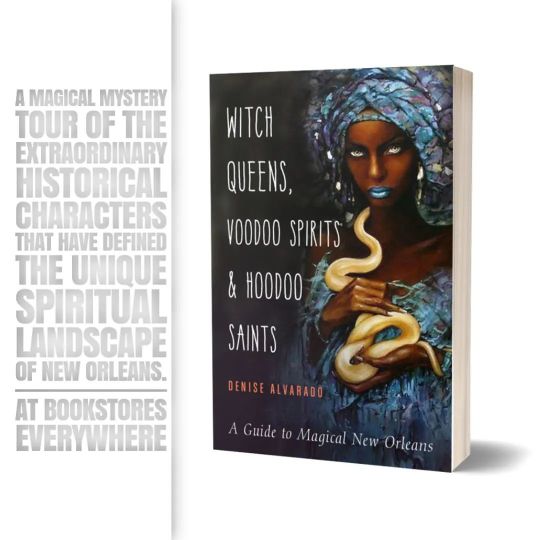
Read all about some of the well-known and not so well-known spirits that are found in the folklore of the city of New Orleans. Annie Christmas, Papa Legba, Baron Samedi, Mary Oneida Toups, Betsy Toledano, Lala Hopkins, Marie Laveau, and Zozo laBrique, to name a few. #witchqueens #witchqueen #hoodoo, #conjure #neworleans #neworleansvoodoo #voodoo #witchcraft #witchybooks (at Saint Johns, Arizona) https://www.instagram.com/p/Ci-tCGspIsM/?igshid=NGJjMDIxMWI=
3 notes
·
View notes
Text
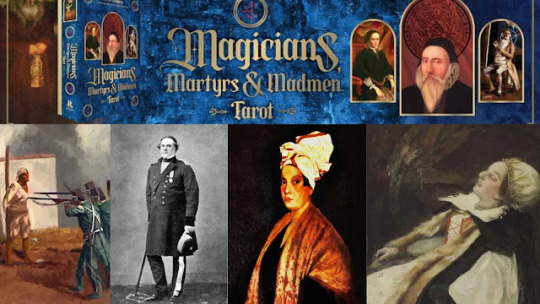
Discover the Magicians, Martyrs and Madmen Tarot Deck
0 - The Fool: James Douglas, The 3rd Marquess of Queensberry Meet James Douglas, the 3rd Marquess of Queensberry, a man characterized as an "imbecile" and "violently insane." Locked away since childhood in Queensberry House in Edinburgh, his life story is as enigmatic as this tarot card.
1 - The Magician: Johann Georg Faust Delve into the world of Johann Georg Faust, commonly known as "Dr. Faustus." He was a scholar and alchemist who made a Faustian pact with the devil, delving into themes of ambition, temptation, and the consequences of selling one's soul.
2 - The High Priestess: Marie Laveau Meet the legendary Marie Laveau, the "Voodoo Queen" of New Orleans, a free woman of color who became a spiritual and community leader through her involvement in Voodoo practices. Her story unfolds in this card.
3 - The Empress: Elizabeth Báthory de Ecsed The infamous "Blood Countess," Elizabeth Báthory, is depicted in all her gruesome glory. Learn about her acts of cruelty and her chilling legacy in this tarot card.
4 - The Emperor: Nero Discover the dark reign of Nero, one of ancient Rome's most infamous emperors. His persecution of Christians and the great fire of Rome are central elements of this card.
5 - The Hierophant: Tomas de Torquemada Tomas de Torquemada, the first Grand Inquisitor of the Spanish Inquisition, stands as a symbol of religious persecution and the fight for orthodoxy. Explore his role in history through this tarot card.
6 - The Lovers: Juliette Bisson, Eva Carrière, Evita & Juan Perón, Sergius and Bacchus This card is a unique blend of historical figures. Juliette Bisson, Eva Carrière, Evita & Juan Perón, and Sergius and Bacchus each bring their distinct stories to the Tarot, encompassing mediums, political figures, and early Christian saints.
7 - The Chariot: Pedro de Alvarado Follow the conquest of Central America and Mexico through the eyes of Spanish conquistador Pedro de Alvarado, a pivotal figure in the history of the Americas.
8 - Strength: Peter Stumpp The infamous German werewolf, Peter Stumpp, takes center stage in this card. His story as one of history's most notorious werewolves is sure to send shivers down your spine.
9 - The Hermit: Edward Kelley Edward Kelley, an English occultist, alchemist, and spirit medium from the late 16th century, invites you into the world of esoteric knowledge.
10 - The Wheel of Fortune: John Dee Explore the mysteries of mathematics, astronomy, and angelic communication alongside John Dee, Queen Elizabeth I's advisor, in this tarot card.
11 - Justice: Matthew Hopkins Meet Matthew Hopkins, the "Witchfinder General," a prominent English witch-hunter during the English Civil War period, as he administers his form of justice.
12 - Ngongo Lutete Discover the compelling story of Ngongo Lutete, a significant Songye leader during the late 19th century, as he rises from enslavement to respected leadership.
13 - Death: Jack the Ripper Unveil the chilling enigma of Jack the Ripper, the unidentified serial killer who terrorized London's Whitechapel district in 1888.
XVIII-THE MOON GREGORI RASPUTIN
Grigori Rasputin, often referred to as Rasputin, was a Russian mystic and confidant of the Romanov family, the ruling family of the Russian Empire. He is one of the most enigmatic and controversial figures in Russian history. Here are some key points about his life:
Early Life: Grigori Rasputin was born in Siberia, Russia, in 1869. He came from a peasant background and was largely uneducated. He worked as a wanderer, sometimes as a religious pilgrim, and later claimed to have had spiritual and mystical experiences.
Rise to Prominence: Rasputin's reputation as a mystic and faith healer spread, and he gained the attention of Tsar Nicholas II and Tsarina Alexandra, who were searching for a cure for their son, Alexei, who suffered from hemophilia. Rasputin's supposed ability to alleviate Alexei's symptoms earned him the trust and favor of the royal family.
Influence on the Romanovs: Rasputin's influence on the Romanovs grew over time. He was often seen as a spiritual advisor and had significant influence over many of their decisions, which led to criticism and controversy.
Controversy and Scandals: Rasputin was widely criticized for his behavior, perceived debauchery, and involvement in political matters. Many Russian nobles and officials viewed him as a charlatan and a threat to the monarchy.
Assassination: Rasputin's influence and scandals provoked deep divisions in the Russian court and society. In December 1916, he was assassinated by a group of nobles who were determined to remove him from the royal family's circle. He was poisoned, shot, and thrown into the Neva River, where his body was later found.
Russian Revolution: Rasputin's murder did not save the Romanov dynasty. The Russian Revolution of 1917 ultimately led to the overthrow of Tsar Nicholas II, the end of the Romanov dynasty, and the establishment of a communist government in Russia.
XX JUDGEMENT - BENDER FAMILY
The Bloody Benders were a family of German immigrants who lived in Labette County, Kansas, in the 1870s. They were notorious for their gruesome crimes, which included robbing and murdering travelers who stopped at their inn, often referred to as the "Bloody Benders' Inn."
The family consisted of John Bender Sr., his wife Elvira Bender, their son John Jr., and daughter Kate. The family operated a small general store and inn, which was conveniently located along the Osage Trail, a popular route for travelers. The Benders would lure travelers to their inn, offer them a meal, and then murder them, often by striking them on the head with a hammer or slitting their throats. Afterward, they would bury the bodies in the garden or basement.
Their crimes went undetected for a time, as travelers often disappeared without a trace, and there were no immediate suspicions of the Benders. However, as more and more people went missing, and rumors of the sinister inn began to circulate, a local investigation was launched.
When authorities searched the property, they discovered several bodies, and it became clear that the Benders were responsible for a string of murders. However, by the time the authorities arrived, the Benders had already fled and were never apprehended.
The Bloody Benders' crimes and their ability to evade capture have made them one of the most infamous and mysterious cases in the history of American crime. The family's gruesome actions have been the subject of numerous books, articles, and works of fiction over the years, and their story continues to be a topic of fascination and horror.
XXI THE WORLD - ALEISTER CROWLEY
Aleister Crowley, whose full name was Edward Alexander Crowley, was a British occultist, writer, and ceremonial magician. He was born on October 12, 1875, in Royal Leamington Spa, England, and died on December 1, 1947. Crowley is one of the most influential and controversial figures in the world of Western esotericism and the occult. Here are some key points about his life and beliefs:
Thelema: Crowley is best known for his role in developing Thelema, a new religious and philosophical movement based on his writings and beliefs. The central tenet of Thelema is "Do what thou wilt shall be the whole of the Law." It emphasizes personal and spiritual freedom, self-discovery, and individual will.
The Book of the Law: Crowley's most famous work is "The Book of the Law" (also known as "Liber AL vel Legis"). He claimed that this book was dictated to him by a spiritual entity named Aiwass in 1904. It serves as the foundational text of Thelema and outlines its core principles.
Occult Organizations: Crowley was a member of several occult organizations, including the Hermetic Order of the Golden Dawn and Ordo Templi Orientis (O.T.O.). He played a prominent role in the development of the O.T.O. and its religious aspects.
Prolific Writer: Crowley was a prolific writer, producing numerous books and essays on occultism, magick, spirituality, and other esoteric subjects. Some of his notable works include "The Book of Thoth" (on tarot), "Magick in Theory and Practice," and "The Equinox" (a series of publications).
Controversy and Notoriety: Crowley's life was marked by controversy and scandal. His libertine lifestyle, recreational drug use, and his public persona as the "Great Beast 666" drew criticism and condemnation from many quarters.
Legacy: Despite the controversies, Aleister Crowley's influence on the modern occult, esoteric, and spiritual movements remains significant. His teachings and writings have inspired many individuals and organizations, and Thelema continues to be practiced by adherents.
Aleister Crowley's life and philosophy continue to be the subject of scholarly study, and his ideas have left a lasting mark on various fields, from spirituality to popular culture. He is considered one of the most important figures in the history of Western occultism.
youtube
Don't miss the chance to add the Magicians, Martyrs, and Madmen Tarot Deck to your collection. Purchase it for £21.75
Your Donations Are Graciously Accepted To Help Me Keep All About Paranormal Online! All About Paranormal is not intended to be for profit, but does carry expenses with domain cost, books, decks, etc. The links I use are affiliate links, I earn a commission for referring you, and the price you pay doesn't change. If you liked my work, please buy me Coffee.


#unboxing#tarot#Youtube#themagiciansMartyrsandMadmenTarotDeck#tarotunboxing#walkthrough#flipthrough#tarotcards#tarotdecks#divination
0 notes
Text
The Mystery Of La Madama. With Altar Set-up And Offering

A peculiar figure has recently become very popular in Rootwork. This person is La Madama. As you look around on different websites, or online blogs about rootwork or hoodoo you find more and more people are speaking on La Madama. But the conversation on her has become more misunderstood and that people are just repeating the same misinformation they are getting from websites and blogs and I'm no way a expert on her but I talked to some priest and practitioners in Espiritismo so I'm writing this post for the people who may be interested in La Madama or just want to learn about how to work with this type of spirit.
Who is La Madama? (Let's say, Who ARE Las Madamas?) Well, what she is not is part of hoodoo nor a hoodoo Saint as it is written online. She is not a slave women. These are dolls that are made out of porcelain or plastic and dressed in a particular color and this is a misconception that it's a specific spirit. This is totally incorrect. A Madama is a category of spirits - to which many individual spirits and guides belong to.

Again the question is who is she? Madamas are spirits of the dead, spirit guides that were slave women (or the descendants of slaves) round in stature, who has the stereotypical look of a house servant from the 1800's. Now Madamas are NOT conjure women (as in false American root workers what have you believe). La Madama isn't considered a the patron of playing card readers and bone readers or divination at least in hoodoo. Madama originated in the Latin community I believe Cuba not the US. These women are typically either women who practiced Espiritismo and maybe Santeria. When these Cuban and Puerto Rican women were alive they are depicted wearing gingham skirts (aprons) in the colors of the spirit which they worked with (red gingham for Chango or Siete Rayos, Blue gingham for Yemaya or Madre de Agua, etc.) They usually have their hair wrapped and there clothing in the same color. There are countless "Madama" spirits out there and they are NOT just one spirit.
Where did Madama Spirits come from? These spirits comes from the latino countries lik (Cuba, Puerto Rico, the Dominican Republic) and has spread to many other countries including Venezuela, part of Mexico and even the southern parts of The United States and This type of spiritualism works differently than the more formal "white table" version of spiritism found in Europe in the late 1800's. There have many categories of spirits including (but not limited to): Madamas, Indians, Gypsies, Nuns, Arabs, and even Pirates. There is not ONE spirit of La Madama, just like there is not ONE spirit of The Indian, nor is there ONE spirit of the Gypsy.
La Madama type spirits is NOT native to Rootwork and has actually never ever been a part of Hoodoo at all until maybe the last 15 to 30 years.
In the south southern root workers used other spirit's such as (Black Hawk) or other spirits or not native to hoodoo but were only found in Spiritualist Churches in the south and some would argue and I read that Christianity, praying the psalms and working with Saints, Indian Spirits, etc. is a rather new to Hoodoo that's incorrect hoodoo in the south has all ways use Christian prayers and Psalms in their practice. The spirit like Black Hawk plays a part later because of what he did and what he represents to us the south especially in Louisiana. Just like Marie laveau these spirits in the South like Louisiana has become important to us, and has become a part of our practice. (See post on Black Hawk)
Can I Work With "La Madama"? This is an interesting question. The answer isn't that simple. It isn't whether you CAN work with La Madama -because you can, The question actually should be "Do I have a Madama to work with me?" In (Spiritism), you don't go out seeking spirits to work with. Instead, you work with the spirits in your Spiritual Court that already surrounds you. The Spiritual Court is a group of the most intimate guiding spirits you have around you that protect and teach you. They are your "inner court" and they defend you when you cannot defend yourself. They guide you, teach you and inspire you. Each person's Spiritual Court is different than the next's. Similar to being initiated in Vodou we get our loa who wants to work with us and be a guide to that person we don't pick or choose which. Madama is the same you must have your own already in your court and a medium can help with identifying your spirits on your court.
Before you can work with her. "Madama" type spirits you need to find out IF THERE IS ONE IN YOUR SPIRITUAL COURT! This is the most crucial element that people don't take into account. You must first find out if you have such a spirit in your court with which to work and identify who is there for you. You can then work with to strengthen your relationship with those guides through prayer, meditation and contact with these spirits at your Spiritual Altar.
It is up to each person to learn as much as they can about their Spiritual Court. These spirits will act as the conduit for divine inspiration and guidance for that person. If you have a Madama type spirit you would need to find out where she's from, her name, what she practiced in her life and how to work with her.
Working and Petitioning La Madama: I would often see photos of people putting offerings to La Madama and petitioning her as if she was a saint. This is absolutely incorrect. She is not. This is not the manner in which Spiritists would ever work with a Madama-type spirit. Because there are many of her so who are you praying too exactly.

Not my photo
Setting up an altar to La Madama: people like to have depiction of her on their altar, like a statue, picture, doll or prayer card. This object acts as a physical container in which her spirit can manifest so when you call opon her for guidance and support. What a glass of water.
Making offerings to La Madama: Madamas enjoy receiving offerings thanking them for their assistance. This could be bouquets of flowers or a cup of coffee or a cigar. If you do leave her offerings, they are offerings of gratitude. Remember she's not a saint. These are given because she came through and helped you with an issue or to keep your connection with her strong.
Ultimately she will help you with reading, perceiving and psychic abilities as well as giving you inspiration when you do a spell or ritual. After all, she was a priestess in her time and knows how to work spells, (but she will tell you how to do it HER way, not the Hoodoo way) (because she was not a conjure woman, she was an Afro-Caribbean *spiritual worker).
One must understand very clearly that God is who we worship. A Madama-type spirit is not a saint to be petitioned. She is a spirit guide. She is there to give you guidance, inspire your spell work, guard you from harm, cleanse you when you pick up something nasty, and to be a teacher and mentor. You do not worship your teacher right so you would not worship La Madama.
If you don't have a Madama-type spirit in your Spiritual Court, that's fine and normal. You may have countless other spirits who are very powerful and close to you. But this internet fad of La Madama really needs to be handled with respect and people should have a better understanding so they don't waste their energy and money trying to petition a spirit that's not even accessible to them. Focus on the spirits that do surround you and keep those bonds strong, and you'll be much better off in the long run.
"Madama" is something originating from Latino countries, not the USA,
#La Madama#How is La Madama#Latina community#Madama spirits#Spirit Guides#like and/or reblog!#spiritual#google search#Altar#Petition la Madama#ask me stuff#follow my blog#african diasporic#african spirituality
27 notes
·
View notes